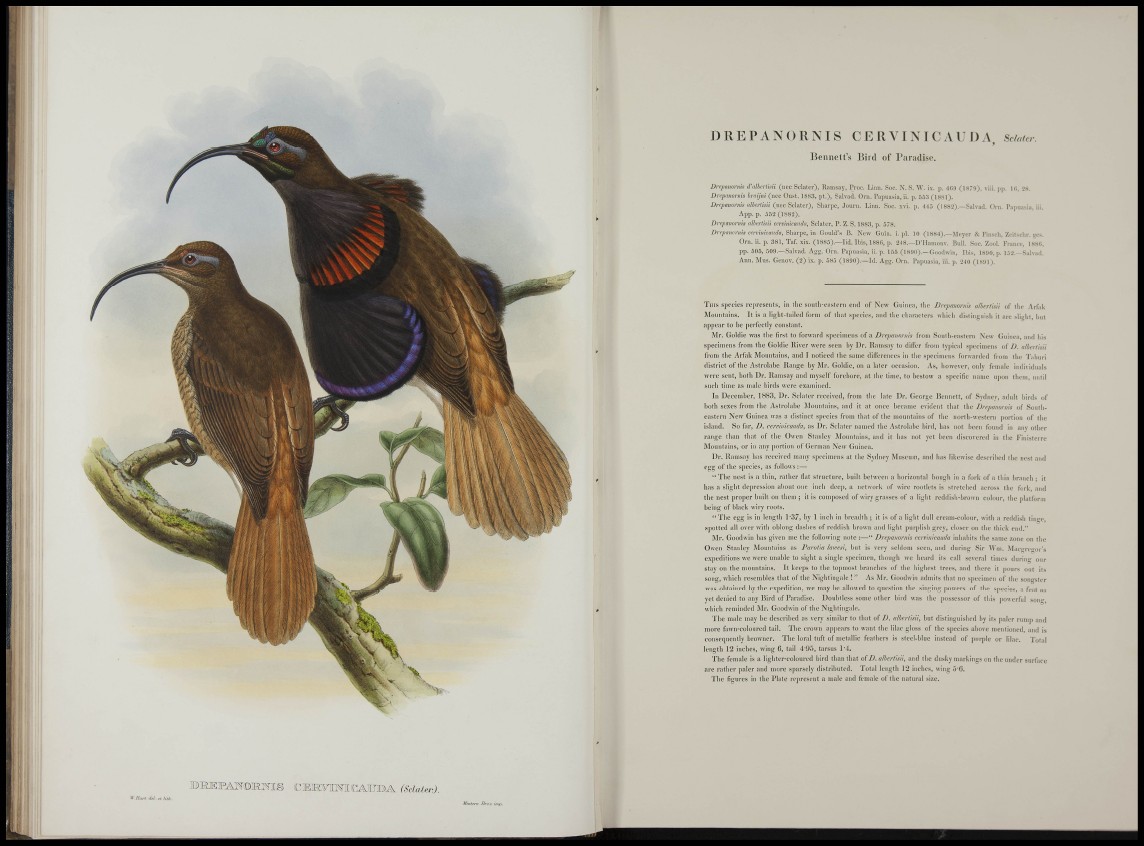
I :
I '
D R E P A N O R N I S C E R V I N I C A U Í) A Sdmer.
J
B e n n e t t ' s ]5ii(l of Paradise.
Vrepaimniis d'alleríisii (iiec Sclatcr), Ramsay, Pioc. Limi. Soc. X. S. ix. p. 4(H) (187!)), viii, jip. Ul, 28.
Drrpanorms hriiijni (nec Oust. 1883, pt.), Salvad. Orn. Vapuasia, ii. p. ."if,:! (1881) .
Drqmmrms albntisii (nec Sclater), Sliarpe, Journ. Linn. Soc. xvi. p. 41j (1882).—Salvad. Orn. I'apuaiia, iii.
App. p. 552 (1S82).
Drqianorms olhertmi ccrvinicauda, Sclater, P. Z. S. 1883, ]). 578.
Drepmwniis cemiiicaiida, Shnvpe:, in Gould's B. New Guin. i. pi. 10 (1884).—Meyer & Filiseli, Zeitsclir. "Cs.
Orn. ii. p. 381, Taf. six. (1885).—l id. Ibis, 1880, p. 2 18.—DTIanionv. Bull. Soc. Zool. France, 1880,
pp. 505, 509.—Salvad. Agg. Orn. Papuasia, ii. p. 155 (1890).—Goodwin, Ibis, 1890, p. 152.—Salvad.
Ann. Mus. Genov. (2) ix. p. 585 (1890).—Id. Agg. Orn. Papuasia, iii. p. 240 (1891).
THIS specics reprcsenls, in llie soiuli-tiistcrn ciui of New Guinea, llie Drqmwrnis oikrikn of tlie Arfak
M o i n i t a i n s . It is a liglit-tiiilcd form of tliat species, and llie cliaractcrs wliieh distinguish it are sliglit, luit
a p p e a r to be perfectly constant.
M r . Goldie was the first to forward specimens of a Drepcamrms from Soulli-castern New Giiinca, and liis
s p e c i m e n s from tlie Goldic River were seen by D r . Uainsay to differ from typical specimens of D. ulbcrt'mi
f r om llie Arfak Mountains, and I noticed tlic same differences in the specimens forwarded from tbe Tabiiri
d i s t r i c t of tlie Astrolabe Range by Mr . Goldie, on a later occasion. As, however, only female individuals
w e r e sent, botli Dr. Ramsay and myself forebore, at llie time, to bestow a specific name upon tlieni, iinlil
siicli time as nuile birds were e.vamiiicd.
I n December, 1883, Dr. Sclater received, from llie late Dr. George Bennett, of Svdnev, adult birds of
b o t h sexes from the Astrolabe Monnlains, and it at once became evident that the Drcpfmorids of Sontiie
a s t c r n New Guinea was a distinct s]iecies from that of the mountains of the norlli-wcstern portion of the
i s l a n d . So far, / ) . cermincaiidat as D r . Sclater named the Astrolabe bird, has not been found in any other
r a n g e than that of the Owen Stanley Mountains, and it has not yet been discovered in the Finislcrre
M o u n t a i n s , or in any ])ortion of German New Guinea.
D r . Ramsay has received many specimens at the Sydney Museum, and has likewise descrihcd ihe nest and
e g g of the species, as follows : —
" T h e nest is a thin, rather Hat slriicture, built between a liorizontal iioiigh in a fork of a thin hraiich • it
has a slight depression about one incli deep, a network of wire rootlets is stretched across the fork, and
t h e nest proper built on them ; it is composed of wiry grasses of a light reddisli-hrown colour, the platform
b e i n g of black wiry roots.
" T h e egg is in length 1-37, by 1 inch in breadth ; it is of a light dull cream-colour, with a rcildi.sb tinge,
s p o t t e d all over with oblong dashes of reddish brown and light purjilish grey, closer on the thick end."
M r . Goodwin has given mc the following note :—" Dycpamrith ccvphucauda inhabits tbe same zone on the
Oiven Stanley Momitains as Farotia lawesi, but is very seldom seen, and during Sir Win. Macgrcgor's
e x p e d i t i o n s we were unable to sight a single specimen, though we heard its call several times during our
s t a y on tbe mountains. It keeps to the topmost branches of tbe highest trees, and there it pours out its
s o n g , which resembles that of the Nightingale ! " As Mr. Goodwin admits that no specimen of the songster
was obtained by the expedition, we may be allowed to question the singing jiowers of the species, a feat as
yet denied to any Bird of Paradise. Doubllcss some other bird was the possessor of this ]ioiverful son",
w h i c h reminded Mr. Goodwin of the Nightingale.
T h e male may be described as very similar to that of D. iilberlisu, but distinguished by its jialcr rump and
m o r e fawn-coloiired tail. The crown ajijiears t o want the lilac gloss of the species above mentioned, and is
c o n s e q n e n l l y browner. The loral tuft of metallic feathers is steel-blue instead of purple or lilac. Tolal
l e n g t h 12 inches, wing 6, tail 4-95, tarsus I'J.
T h e female is a lighter-coloured bird than that o^D. alherthii, and the dusky markings on the under surface
a r e rather paler and more sparsely distribnted. Total length 12 inches, wing O'G.
T h e figures in ihe Plate represent a male and female of the natural size.
| l
l l : li
| i it II
Il IL
[ i :rii
t i l l
J D ) 3 5 J E P A W © S m S C J E m ^ T i m r ^ U I D i ^ (SdaUn) .
W-Hoji del <t UlA.